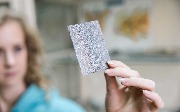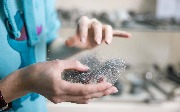MAI developed the technology of manufacturing porous titanium for prosthetics
Moscow Aviation Institute developed the technology of manufacturing unique material for prosthetics, made of titanium fibers welded together. The material is biocompatible, and due to its high porosity and suitable pore size, bone tissue easily grows into it, forming one structure with the implant.
The project is being carried out by scientists of the Institute No. 11 "Materials Science and Technology of Materials" MAI. One of the research teams led by Professor Mikhail Serov proposed a method of high-speed solidification of the melt to produce thin titanium fibers resembling metal wool. Another team with the support of the Ministry of Education and Science of Russia developed a method of thermohydrogen treatment that promotes sintering of such fibers.
– Metal fibers are pressed into blanks in the form of a cylinder or a flat sheet, after which they are processed, – says Mikhail Kollerov, project manager, Professor of the Department of Materials Science and Technology of Materials Processing at MAI. – We introduce hydrogen into the metal, which contributes to changing the structure and properties of the material. There is diffusion welding, sintering of fibers. After removing the hydrogen, we get such a material that is tangled, but also welded fibers, with very good porosity – about 50-70% and a pore size from 30 to 300 microns.
Porous titanium can be used to recreate destroyed vertebrae capable of forming a single bone block with adjacent vertebrae. In addition, sheet blanks from the new material can be welded to monolithic implants, creating a porous surface. Such a coating is suitable, for example, for elements of endoprostheses of joints like hip, knee, etc. It is also possible to cover the bone directly with sheet material, which will help to strengthen it by growing into the metal.
As an alternative to this method, 3D printing from titanium can be used. However, in this case, it is almost impossible to achieve the required pore sizes necessary for effective bone tissue germination. Another alternative is the method of sintering titanium granules to form porous structure, but in this case another problem arises.
– If one of the granules breaks away from the material and begins to migrate through the body, the consequences can be unpredictable. For example, the ingress of such a particle into the articular pair of friction can lead to the failure of the prosthesis and repeated surgery," explains Professor MAI. – The method of diffusion sintering of fibers allows to get a much stronger and more reliable connection and not harm human health.
As the developer notes, the material has already found application in veterinary medicine: for example, in the treatment of fractures in dogs. In the coming years, the team expects to transfer the technology to the production of medical devices.


